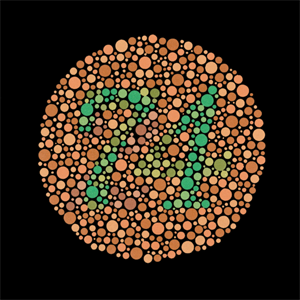Answers for Pilots: Color vision
Know the medical certification requirements
 About 8 percent of men and 0.5 percent of women in the United States have problems with color perception. Whether caused by inheritance, injury, or disease, color blindness is challenging to live with and presents some hurdles for pilots. The medical standards in FAR Part 67 specify that applicants for all classes of medical certification have “the ability to perceive those colors necessary for the safe performance of airman duties.” Every visit to an AME for renewal of an airman medical certificate involves taking a color vision test. Technically known as a pseudoisochromatic color plate test, it’s the one with the pages of different-colored dots.
About 8 percent of men and 0.5 percent of women in the United States have problems with color perception. Whether caused by inheritance, injury, or disease, color blindness is challenging to live with and presents some hurdles for pilots. The medical standards in FAR Part 67 specify that applicants for all classes of medical certification have “the ability to perceive those colors necessary for the safe performance of airman duties.” Every visit to an AME for renewal of an airman medical certificate involves taking a color vision test. Technically known as a pseudoisochromatic color plate test, it’s the one with the pages of different-colored dots.
FAA made some changes to color vision testing in July 2008. If you hold a statement of demonstrated ability (SODA) or a letter of evidence that was issued before July 2008, your color vision waiver is grandfathered, and you will not be required to test according to the new procedures described below.
Here are the testing details.
If you fail the color vision test in the AME’s office, you can still fly, but with a limitation – no night flying or color signal control. Not a problem if you are a day flyer. If you’re not happy with the limitation, though, it is possible to have it removed by taking an alternative color plate test. There are a few of them to choose from, including the Dvorine second edition 15-plate test or one of the Ishihara tests. Call your optometrist or ophthalmologist to see which test is available. These tests take into account the degree of color vision defect and are less sensitive to mild color vision deficiency.
If you pass the alternate test, FAA will consider your color vision acceptable. You will, however, need to take a color vision test each time you reapply for a medical certificate, so try to take the same test that you previously passed each time you reapply. When you see the AME for your FAA exam, bring a letter from the vision specialist that states the type of color vision test and the passing results. The AME may then issue the new certificate without a color vision restriction.
Applicants for a third class medical:
- If you do not pass the alternate test, you still have another option. You can take an operational color vision test (OCVT) with an FAA aviation safety inspector through the local flight standards district office (FSDO). This test has two components: A signal light test taken at an airport and a practical test in which you must correctly identify colors on aeronautical charts.
- If you pass both parts of the OCVT, the aviation safety inspector will issue a letter of evidence and a medical certificate with the limitation “3rd Class Letter of Evidence.”
- If you fail the signal light test portion of the OCVT during daylight hours, you will be able to retake the test at night. If you pass the nighttime test, your medical restriction will read, “Not valid for flights requiring color signal control during daylight hours.” If you cannot pass the OCVT during day or night hours, the restriction will read, “Not valid for night flying or by color signal control.”
- If you fail the daytime signal light test, you are not eligible for either first or second class medical certification, may not be issued a letter of evidence, and may not have the limitation modified or removed.
Applicants for first or second class medicals:
- Successful completion of an operational color vision test (OCVT) described above; and
- A color vision medical flight test (MFT). This is an actual flight test and requires the following:
- Reading and correctly interpreting aviation instruments or displays, particularly those with colored limitation marks, and colored instrument panel lights, especially marker beacon lights, warning or caution lights, weather displays, etc.
- Recognizing terrain and obstructions; selecting several emergency landing fields, preferably under marginal conditions, and describing the surface (for example, sod, stubble, plowed field, presence of terrain roll or pitch, if any); as well as identifying obstructions such as ditches, fences, terraces, low spots, rocks, stumps, and, in particular, any gray, tan, or brown objects in green fields.
- Visually identifying the location, color, and significance of aeronautical lights including
- Colored lights of other aircraft in the vicinity;
- Runway approach lights, including both the approach light system (ALS) and visual glideslope indicators;
- Runway edge light system;
- Runway end identifier lights;
- In-runway lighting (runway centerline [CL] lights, touchdown zone [TDZ] lights, taxiway lead-off lights, and land and hold short lights);
- Airport boundary lights;
- Taxiway lights (edge lights, CL lights, clearance bar lights, runway guard lights, and stop bar lights;
- Red warning lights on television towers, high buildings, stacks, etc.;
- Airport beacon lights.
- If you pass the operational color vision test (OCVT) and the color vision medical flight test, the inspector will issue a letter of evidence that’s valid for all classes and a medical certificate with no limitation or comment regarding color vision.
- If you fail the signal light test portion of the OCVT during daylight hours, you will be able to retake the test at night. If you pass the nighttime test, your medical restriction will read, “Not valid for flights requiring color signal control during daylight hours.” If you cannot pass the OCVT during day or night hours, the restriction will read, “Not valid for night flying or by color signal control.”
Because this new policy is complicated by the need to interact with the local FSDO, AOPA recommends that pilots who need only third class medical certificates try one or more of the alternate color plate tests first. If that fails, do a “trial run” of the signal light test during daylight hours with the air traffic control tower first, preferably with someone who has “normal” color vision, to confirm that you correctly identified the tower light signals. When you know you can pass the test, you can contact the FAA for approval to take the test.
Questions? Give AOPA a call at 800/USA-AOPA (872-2672).



